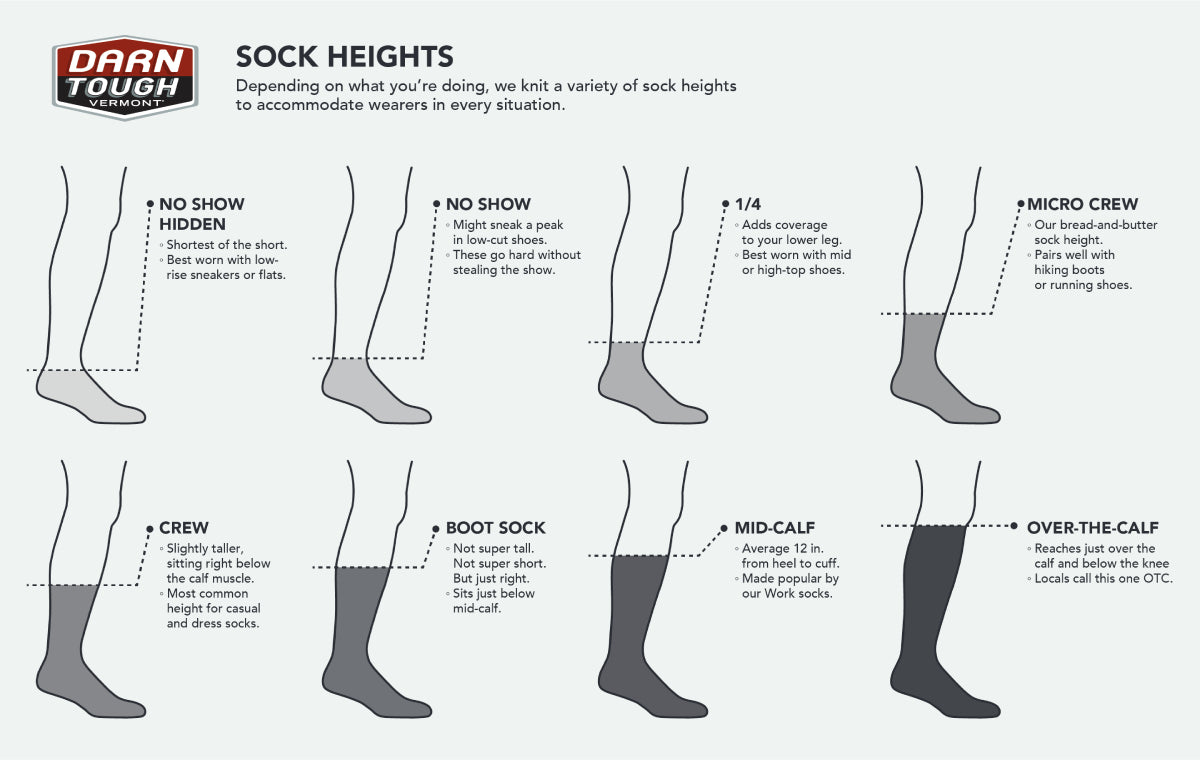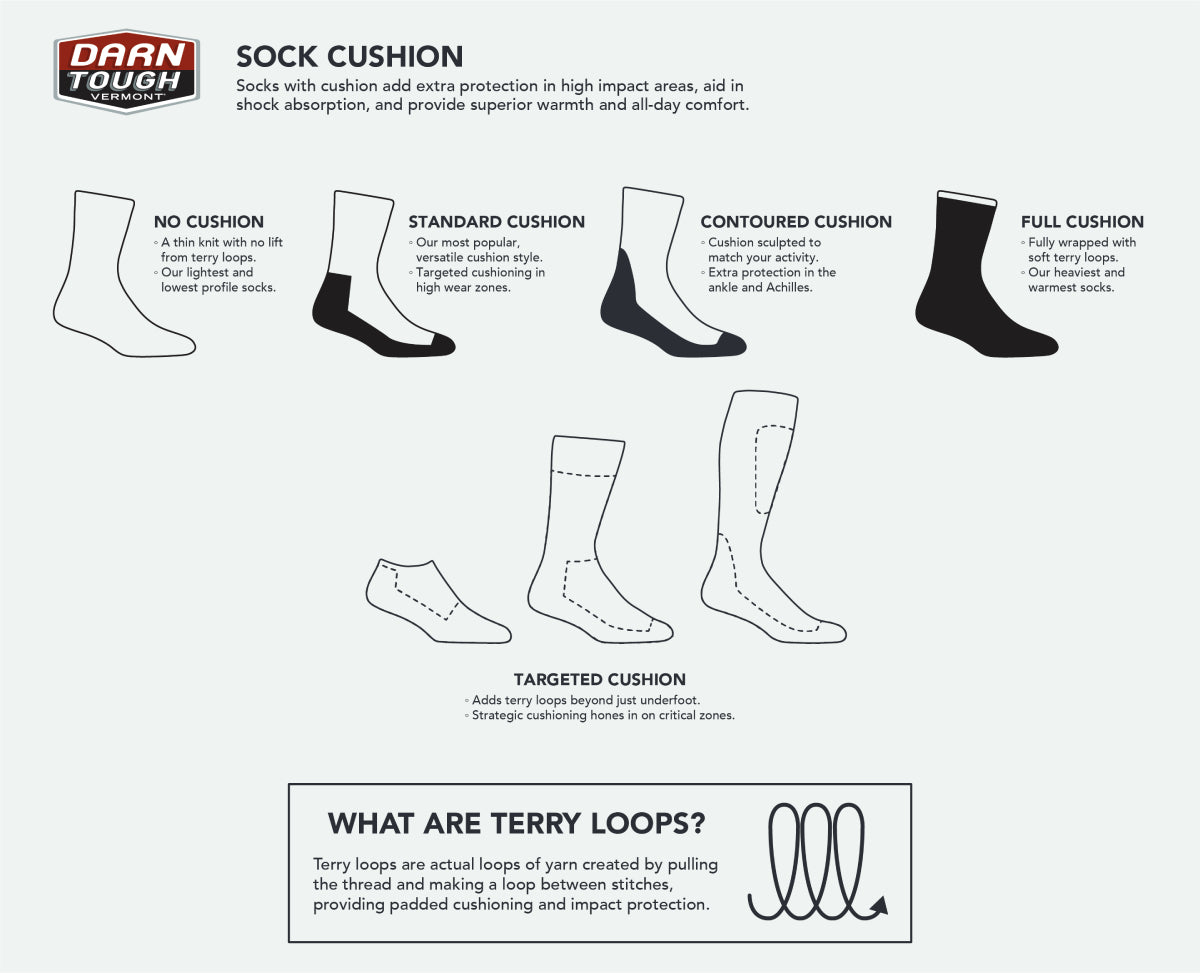Different Types of Socks: A Complete-ish Guide

There are a lot of types of socks; trust us, we know. Working at a sock company, you quickly learn that there are so many different types of socks, with no shortage of ways to group and categorize them. And with such a variety, it can be overwhelming to understand your options.
To make things a little bit easier, we made a (mostly) comprehensive, no-nonsense downloadable guide on all types of socks. We also have a comprehensive guide on How to Choose Socks, if that’s what you’re looking for.
Socks By Height

One of the first and most common ways to categorize socks into different types is to consider them by their heights. It makes sense, as finding your footwear often dictates how tall or short you want your socks to be. Generally speaking, you can group socks into four height groups (though we knit way more than that):
- No Show socks
- Ankle socks
- Crew socks
- Knee High socks
Let’s consider these from shortest to tallest.
No Show Socks
No Show socks are exactly what they sound like — these are socks designed to be invisible when your shoes are on, and typically those shoes are low-tops. Though they come in a range of options, the rule of thumb for no show socks is that they rise no higher than your ankle.
At Darn Tough, we knit no shows ranging from Invisible (for a truly no-sock look in even your boat shoes) to No Show Tab running socks, which rise to just below the ankle and have tabs for a secure, no-blister fit. No show socks are often a go-to for casual and athletic settings, perfect for footwear ranging from dress shoes to sneakers.
Ankle / Quarter / Shorty Socks
Next up, we hear a lot about ankle socks. The definition around this sock type is a bit more hazy than no shows, but if the sock sits right below, on, or just over your ankle, probably a safe bet to call it an ankle sock.
Now, you won’t see any socks labeled “ankle sock” on our site, but safe to say we’ve got you covered. We knit two different types of ankle-reaching socks. Our Quarter height is perfect for low cut hiking boots and the similar Shorty height gives a nice flair in ankle height boots. These are some of the most common heights for casual socks.
Crew, Micro Crew, Boot & Mid-Calf Socks

The Crew sock category is arguably the most popular and most famous sock height. The sock multi-pack your parents used to keep your toes covered all through childhood? Yeah, those were probably crew socks.
Traditional crew socks sit around mid-calf, though the exact length may vary from company to company. At Darn Tough, we knit crew socks… and we also knit several other heights in the mid-calf leg range, something for every. These range from sitting just below the calf muscle, like our Micro Crew height (our own invention), to well past the calf mid-way point, like our Boot Socks, and everything in between.

Knee High / Over-the-Calf Socks
Finally, we have knee high socks. At Darn Tough, we call these Over-the-Calf socks - both names get at the definition. This type of sock covers your entire calf and ends just below your knee cap. They’re the preferred height for many sports, extremely cold days, or extra tall boots. These are the best .
There is a sock height for every occasion, and each height has its benefits. If you want to learn more about the different heights in socks and when you would want to wear each height, check out our comprehensive sock height guide.
Socks By Weight

Arguably one of the most important ways we categorize socks is by weight. In this case, the weight of the sock doesn’t refer to numbers on a scale but instead the relative thickness of the yarn used to knit it, impacting the warmth and on-foot-feel. Generally the thicker the yarn is, the warmer the sock will be.
There are four types of weights that socks get categorized as:
- Ultra-Lightweight (or Ultralight) socks
- Lightweight socks
- Midweight socks
- Heavyweight socks
Let’s talk about these from lightest to heaviest.
Ultralight Socks are the thinnest and lightest socks out there — a ghost of a sock. The thinner fabric allows for ventilation, making these the most breathable sock weights. These are often used for running or working out, but they work great for anyone who wants an incredibly thin sock to keep things light on their feet.
Next up, we have Lightweight socks. Lightweight socks are often used as dress socks to go with dress shoes. Due to the versatility of this sock weight, they are also great for everyday socks or casual socks.

Midweight socks offer the right feel and comfort for year-round wear and can be worn on most days (especially if they are Merino Wool). Midweight is Darn Tough’s most popular weight for hiking socks, and it’s what we use in the 1466, our best selling sock.
Finally, we have Heavyweight socks. Heavyweight socks are the thickest and warmest socks out there. These are made for the coldest days and most extreme conditions… or for that slipper sock feel. Many people opt for heavyweight socks for activities like mountaineering or hunting.
For the best results, choose the sock weight that fits your needs and preferences. To learn more about different sock weights and when each one is best, check out our complete guide to sock weights.
Socks By Material

An important yet often forgotten factor when shopping for socks is material. Many people just walk into the store and buy socks in the height and color they like. If you take one thing away from this guide, remember this: the materials the sock is made of and the features associated with those materials matters. Here are some common sock fabric types:
- Merino Wool socks
- Polyester socks
- Cotton socks
Let’s break down these materials.
In our experience, Merino Wool is the best material to have in a sock. It’s extremely durable, moisture wicking, thermoregulating, and odor eliminating. Don’t believe us? Ask the Merino sheep who have been wearing, hiking in, and testing Merino Wool for over 10,000 years!
If you don’t want to use wool, there are other options that try to mimic the properties of Merino Wool. There are synthetic polyester options that have many similar benefits to Merino Wool, but are only mimicking what Merino does naturally.
At Darn Tough, we make select socks out of Coolmax and Thermolite to provide thermoregulating, moisture wicking, vegan sock options.

Finally, we have the cheapest and perhaps common option, which is cotton. Though it is usually cheaper than the other materials, this is a case where you get what you pay for. Cotton socks are not odor resistant, have a shorter lifespan, and don’t wick moisture.
While we believe Merino Wool is the best material to have your socks knit with, there are a ton of other fabric options out there. If you’re interested, you can read more about Merino Wool vs. other sock materials.
Socks By Cushion

Also called padding, cushion is extra material knit into the sock (or areas of the sock) via terry loops. Choosing the amount of cushion comes down to preference and activity type. When you’re on your feet for miles or hours, it can be nice to have some extra cushion for comfort. Here are a the main types of sock cushion options:
- No Cushion socks
- Cushion socks
- Full Cushion socks
Let’s talk about these from the lightest cushion to the maximum cushion.
No Cushion socks have no padding or cushion to reduce the impact on your feet. The lack of extra fabric from the terry loops keep things light, breathable, and low profile.
Cushion socks have terry loops running along the bottom of the foot and in high impact areas. These offer a good balance between cushion benefits and breathability. You can further break this down into three types:
- Standard Cushion - the ATV of cushioning profiles with cushion underfoot, over the toe, and up the heel, good for thru-hiking and cruising around town.
- Contoured Cushion - we sculpt the Terry loop placement for a precise match to your activity, including Terry loops extending up the Achilles.
- Targeted Cushion - Terry loops added beyond underfoot for specific scenarios. For example, we make a work sock that has extra cushion in the toe to prevent numbness from steel toe boots. We also make ski socks with padded shins for extra comfort on the mountain.
Full Cushion socks have terry loops running throughout the entire sock to create a super padded sock that protects your feet as much as possible, adding warmth, comfort, and durability.

Is cushion right for you? You can learn more about what cushioning is and the different types in our Complete Guide to Sock Cushion.
Socks By Activity & Occasion
While most of our socks can be worn on most days, we do combine our technical features to cater to specific activities.When it comes to different types of socks, we’re firm believers that the most technical footwear will only get you so far without an equally technical sock — just one reason we knit activity-specific socks.
The sock type you choose should match the activities, shoes, and weather you're facing. Even the best boots or sneakers only work as well as the socks underneath them. That's why we knit boot socks, ankle socks, and everything in between using the right materials, fibers, and cushioning to provide comfort, durability, and the right coverage for any day.
Hiking, Hunting, & Long Days in Boots
Hike and hunt socks are built for durability, protection, warmth, and cushion inside rugged boots. Merion Wool helps regulate temperature, while reinforced knits reduce friction on steep climbs, uneven terrain, or long work days. These socks excel anywhere you spend serious time on your feet.
Our most popular category of socks is our Hike sock category. Hiking socks complement your trail footwear, keeping your feet dry, comfy, and blister-free. These socks come in all different types ranging from ankle to over-the-calf length and lightweight to heavyweight.

Hunting socks are made to be rugged and hold up to tough conditions, while keeping your feet warm and sweat-free. Our hunting socks come in different weights for every season and feature cushion around the calf to protect against boot lace pressure.

Running, Training & Athletic Activities
For running and athletic sports, socks should be breathable, durable, and built for movement. Our ultralight and lightweight options are designed to wick moisture, stay secure on the foot, and provided targeted support without sacrificing comfort. We knit our running socks in heights ranging from no-show to crew, for everything from trail runs to road races.
Everyday Wear & Casual Use
You won’t hear many people looking for Lifestyle socks; by name — but if you’ve ever just needed socks, this type is probably what you meant.
For daily life (walking, commuting, and getting out the door), lightweight crew socks or ankle socks are the most popular choice. These Merino Wool socks stay fresher than cotton and offer dependable comfort in low-cut shoes, casual sneakers, or slip-ons.
Office, Dress, & Fashion Forward Days
On days when you want a clean look and sharper style, go for dress socks. Low-profile Merino crew socks fit smoothly into dress shoes without bunching at the toe or sagging around the calf. Dark colors blend in under trousers, and the smooth fabric offers all-day comfort.
Snow, Ski & Cold Weather Sports
Snow socks and ski socks are designed for winter sports, often skiing and snowboarding, where a low-profile fit inside technical boots is essential. These over-the-calf socks deliver warmth without bulk, and the materials manage moisture so your feet don't freeze out before the day is done. In addition to our adult styles, we also knit ski socks for kids.
For those who cross-country ski, our nordic ski socks are knit at a boot height to accommodate cross country ski boots, snowshoes, and ice skates.
Tactical & Work
For mission-ready days or long hours on the job, you want socks built for durable performance and dependable support, not matter how many hours they're worn.
Tactical socks are designed to meet the requirements of US military branches so they can be worn with uniforms, from PT to combat. Darn Tough’s tactical socks are Berry compliant and available in military spec colors.
Work socks are made to be durable, comfortable, and protective for those spending long days in heavy boots, steel-toes, or rubber footwear. They keep the leg protected, reduce rubbing, and stay firmly in place without slipping.

Socks By Pattern
Now it’s time for everyone’s favorite part… patterns! While it won’t affect performance or comfort, sock designs are a great way to show off your style and express your personality. As an added bonus, socks with unique patterns are much easier to match in the wash.
There are thousands of different sock patterns out there and unlimited possibilities for future sock patterns, but here are a few of our favorite types.
Solid & Colorblock Socks
If you’re looking for something classic and minimal, our Solid and Colorblock socks are a go-to for any occasion, featuring just one or two colors, they're sock-drawer staples. These classic socks are simple in pattern, but packed with features.
Striped Socks
The best time to wear a Striped sock is all the time. You can almost never go wrong wearing stripes. Whether you’re dressed casual or formal, these socks will get the job done.
Animal Socks
Now for one of our favorite types of socks – Animal socks. These are some of our favorite to design; there are so many ideas to choose from. Who doesn’t want a gorilla eating a banana in a banana hammock or a raccoon stealing jelly sandwiches on their socks? And which you pick might say something about your personality.

Nature Socks
Our Nature socks are inspired by the scenes people see when they outdoors in Darn Tough socks. From mountains to flowers to lurking sea monsters, you never know what you will find in nature (or on our nature socks).
Holiday Socks
Holiday socks feature designs and colors inspired by all things winter and festive. These socks are a great pick for matching family photo opps.
Who says trick or treating isn’t hiking? Enhance your favorite Halloween costume with a spooky set of Halloween socks, from mystical stripes to mythical creatures in dark forests.
Red, White, and Blue Americana Socks
Americana socks are great when you want to show your colors and patriotism. We are proud to be an American company whose products are designed, tested, and manufactured in the USA, with the highest quality materials sourced from American and around the world. These red, white, and blue socks share our pride and help others do the same.

Abstract & Artsy Socks
If you’re the type of person who likes to walk around looking like a MoMA exhibit, our Abstract socks are the socks for you. Jokes aside, these patterns are funky and unique and will be sure to turn heads.
Coming up with new patterns, designs and scenes to put on socks is one of the most fun things we get to do here at Darn Tough. If you want to learn a little more about the design process, follow along in Sock 201: How to Design and Develop Socks.
Other Common Sock Types
There are types of socks we don’t make, and we'd be remiss not to mention them. We rely on our extensive research and development process to determine what the best sock heights are and what we should carry in our line. And there are few we choose not to make. To name a few:
Toe Socks
Toe socks are socks that encase each of your toes individually. Here at Darn Tough, we've found that toe socks are not necessary to prevent blisters if you've got the right socks and a shoe with ample toe room.
Sock Liners
Similar to toe socks, we find that sock liners are unnecessary if you have properly fitting boots and Merino Wool socks with a Performance Fit. Our in-house sock and hiking expert did a great job explaining why you probably don’t need them.
Compression Socks
We used to knit compression socks; however, our rigorous product testing revealed what we felt was an unacceptable level of inconsistency in compression. We knew that if we couldn't guarantee these as the most comfortable, most durable, best fitting graduated light compression socks out there… then we had to reconsider.
Thigh High Socks
We don’t make thigh high socks; for our tallest socks, you’ll want Over-the-Calf. Our focus at Darn Tough is on knitting high performance socks for specific activities, and we find that sock needs for those activities stay at or below the knee, like the accompanying footwear.
What to Wear With What: A Brief Sock + Shoes Pairing Guide
You can pick a great sock. You can pick a great shoe. But pairing the right length and cushion with the wrong shoe? That’s how blisters and bad days happen. Here’s a straightforward overview to make sure your socks and shoes actually like each other.
No Show & Low Cut Socks → Low-Profile Shoes
Think boat shoes, loafers, casual sneakers. You want minimal coverage without sacrificing comfort. Perfect when you’re going for a clean, low-visibility style.
Ankle Socks / Quarter / Shorty → Sneakers & Light Boots
Daily drivers. Enough height to prevent rubbing, but not so much that it climbs the leg. Great for walking, commuting, and active days.
Micro Crew & Crew & Boot → Everything from Sneakers to Hiking Boots
The “just right” option. A reliable balance of protection, warmth, and comfort. Ideal when you want dependable support for all-day wear.
Over-the-Calf → Tall Boots, Work Boots, Cold Weather
When your footwear climbs high, your socks should too. OTC socks help lock in warmth, improve comfort, and prevent hot spots.
Pro tip: If your socks are fighting your shoes for space, change them. The right pair works with your footwear, not against it.
Socks for Everyone

That wraps up this complete-ish sock guide. We won’t deny it’s a lot of socks – DarnTough.com is home to well over 1,000 different socks — but we strive to offer the best socks for every foot. If you’d like additional helping choosing the right socks, we put together a helpful sock quiz to point you in the right direction.
Download Darn Tough's quick reference guide to the different types of socks here.







